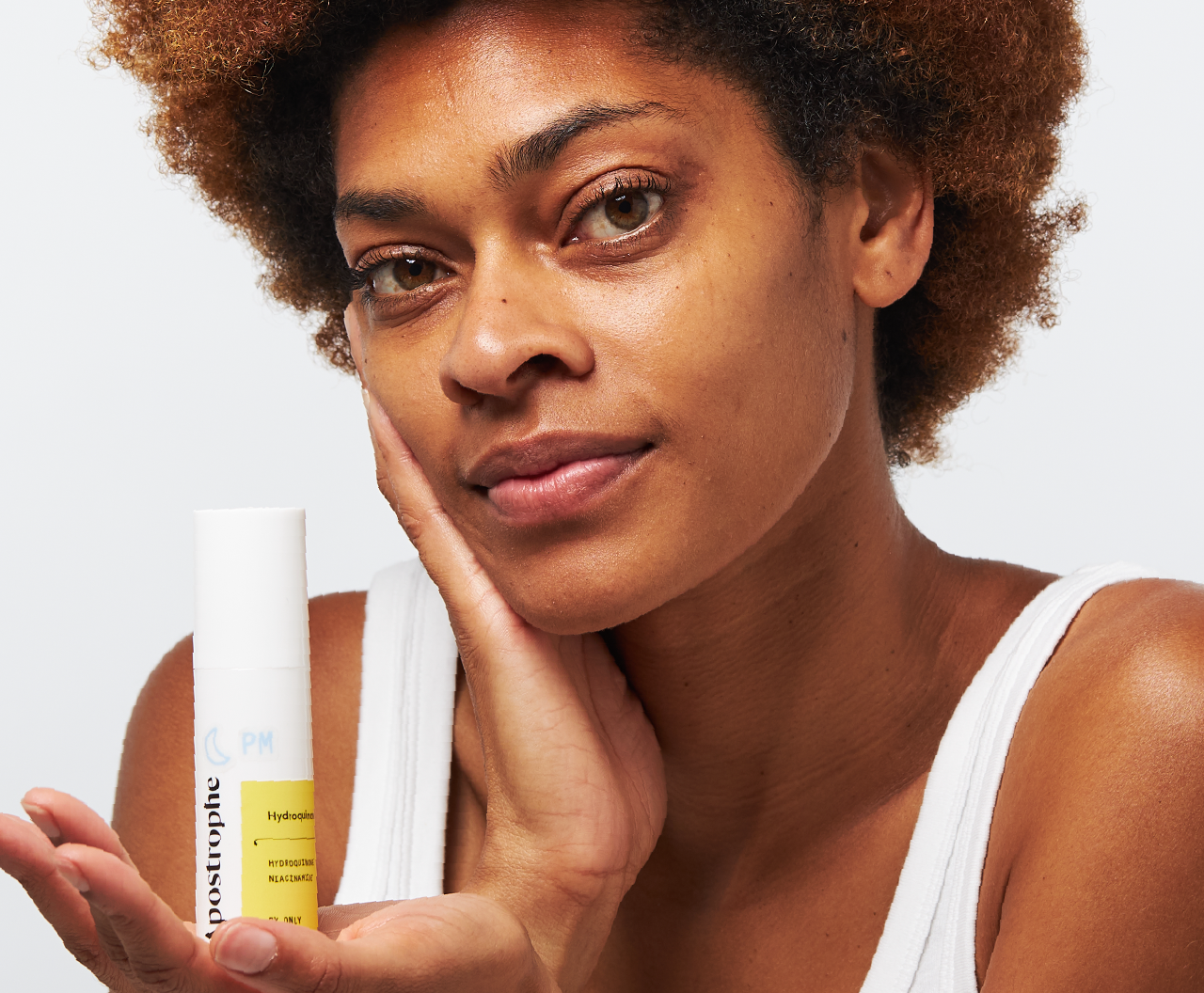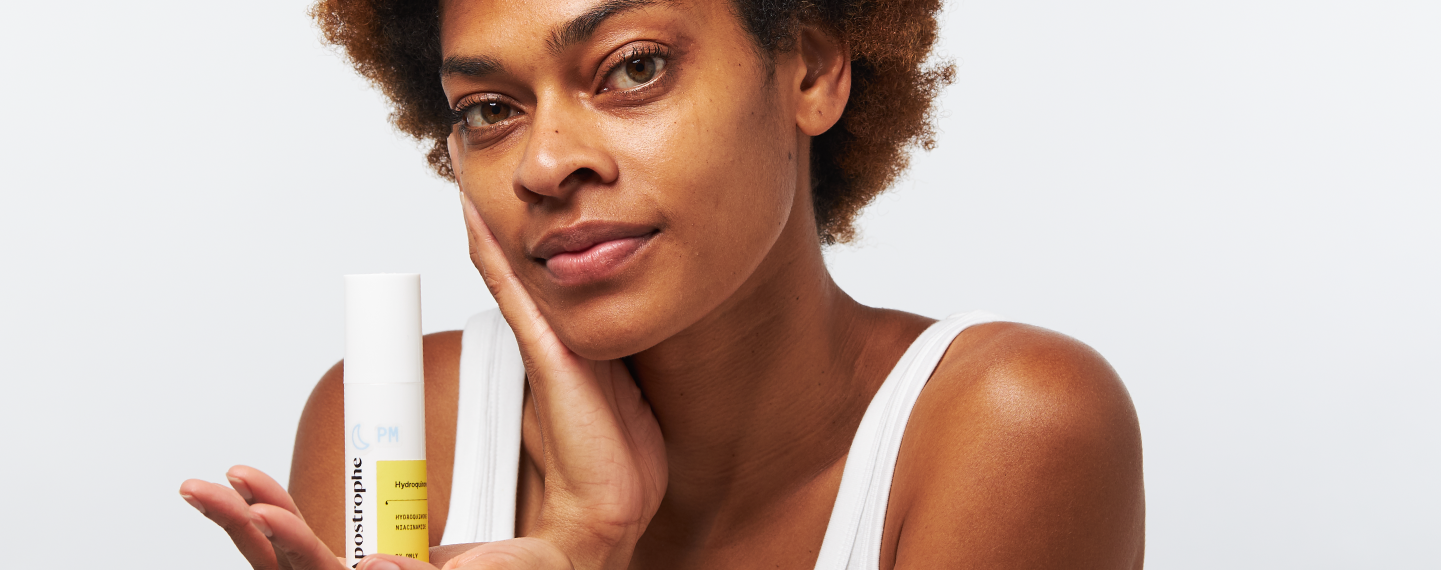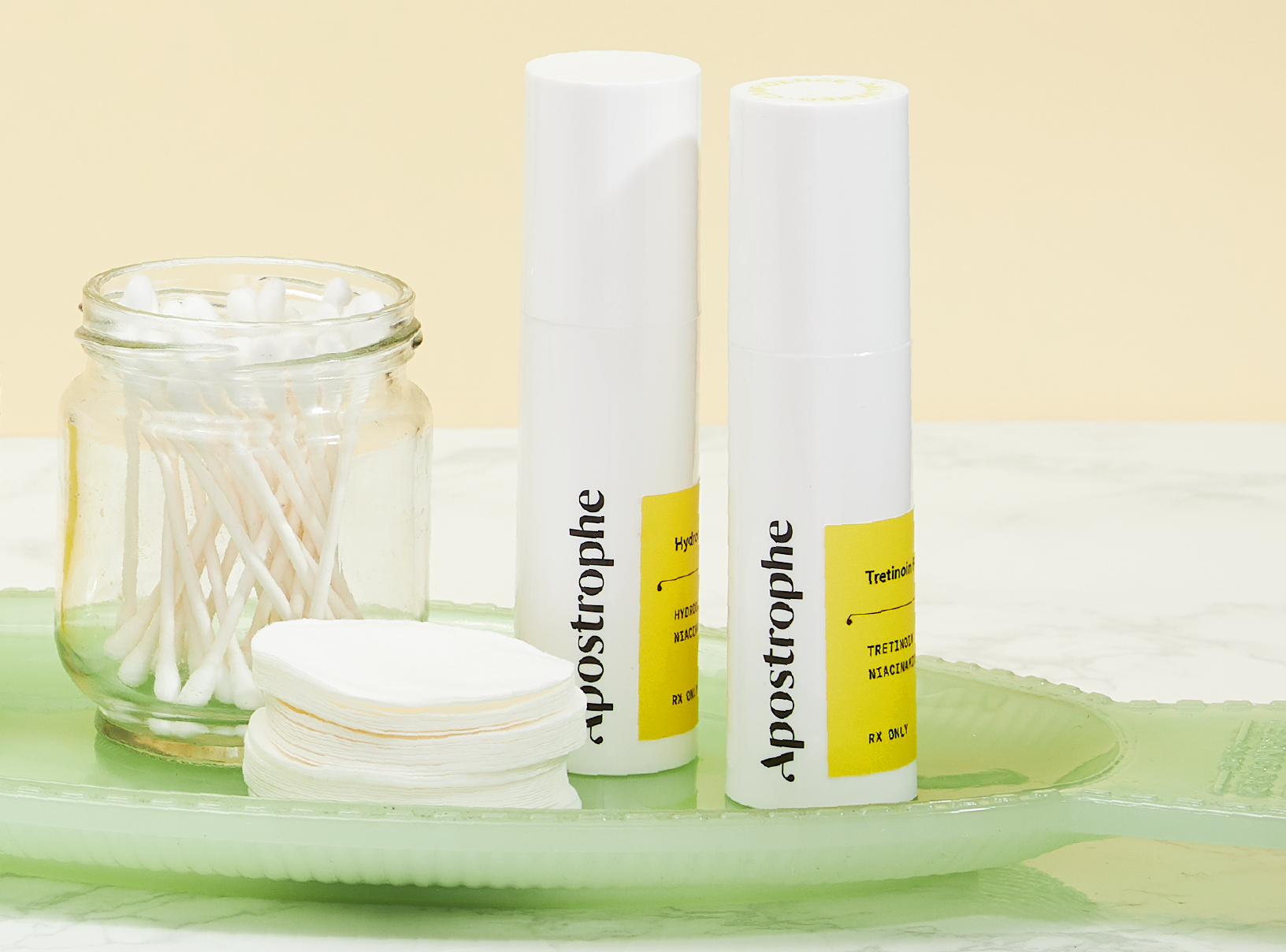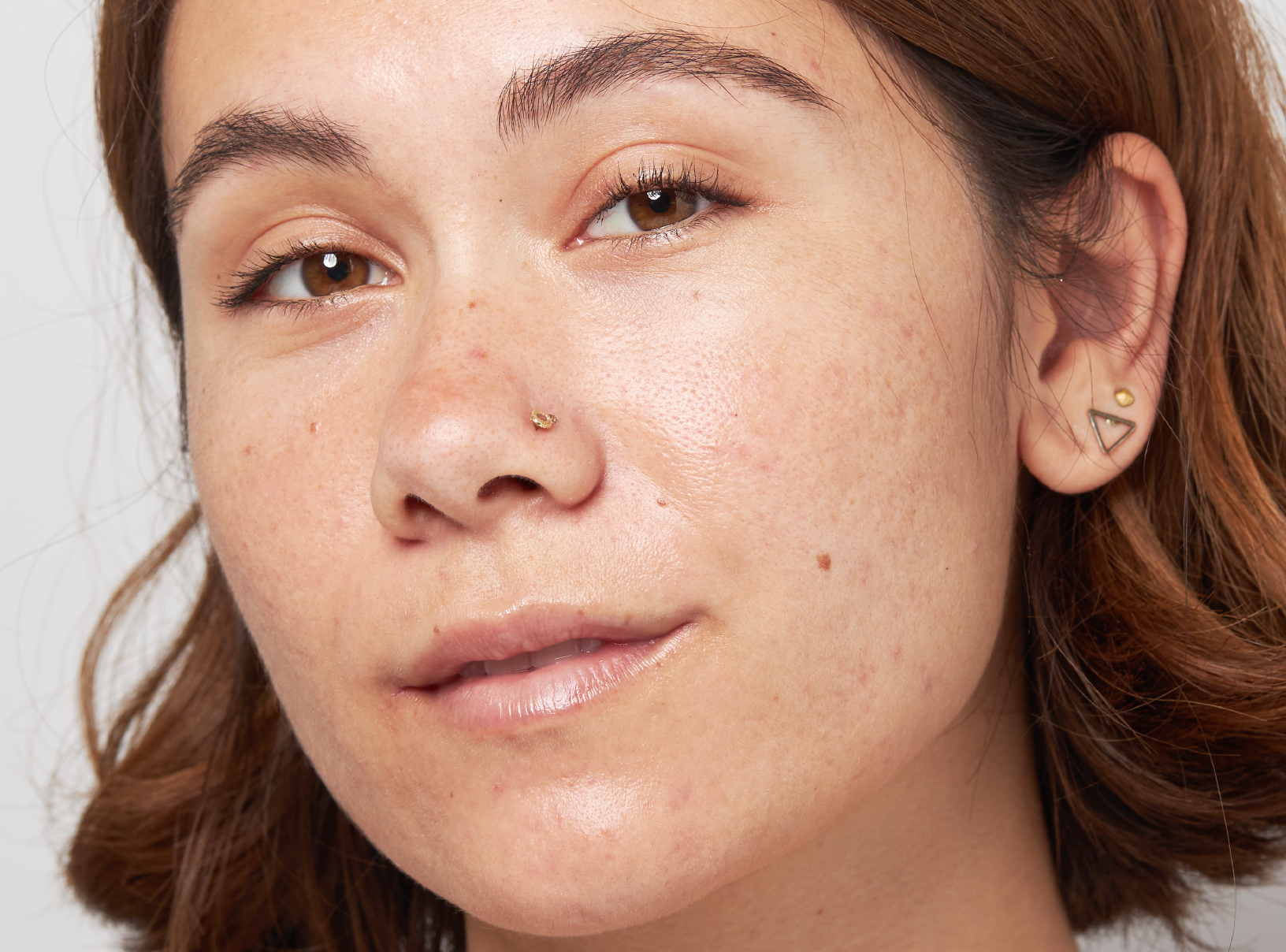Education
Hydroquinone Acne Scar | Apostrophe


SHARE
Education
Hydroquinone Acne Scar | Apostrophe
Medically reviewed by Aimee Paik, MD
Written by Apostrophe Team
Last updated 11/1/2024
Pimples are enough of a nuisance on their own. But when the aftermath of your acne breakout leaves you with unwanted scars, it can make matters even worse. There is, however, an ingredient out there that’s working hard to help you feel happier and more confident in your skin.
If you’re dealing with dark spots left by acne, azelaic acid and hydroquinone are two commonly-used treatments. Hydroquinone is a skin-lightening agent that can be used for a number of conditions, but it could be the treatment you’ve been looking for to help address leftover marks and scars. So, what exactly is hydroquinone? How long does it take for hydroquinone to work and how effective is it in brightening and evening out your skin tone? All the information you need and more in the blog below.
What is Hydroquinone?
Knowing what a product and its active ingredient can do before using it on your skin is the first step in taking control of your skin care journey. Your organic chemistry teacher would tell you that hydroquinone is a phenolic bleaching compound that works to prevent the development of melanin in your skin.
The translation? It’s a tried and true method used to brighten dark spots caused by excess sun exposure, hormonal changes, and pimples that probably would have been better off untouched. It can target those stubborn acne scars but it’s also an effective ingredient in the treatment of other skin conditions such as:
Melasma
Age spots
Post inflammatory hyperpigmentation marks caused by acne
Freckles
You’ll find it mostly in a variety of topical forms such as gels, creams, emulsions, and lotions. Once available as over-the-counter skin discoloration or dark spot corrector, it is now only available when prescribed by a dermatology provider—usually in 4-6% concentration.
How does hydroquinone work its magic with acne scars? It’s not magic, actually—it’s science! Grab a pen and paper, and take a few notes as you make your way through the section below.
Why is Hydroquinone an Effective Treatment for Acne Scars?
You know the what, but how about the why? Why exactly is hydroquinone such a powerful tool when it comes to fighting off not just acne scars but melasma and other forms of hyperpigmentation too?
Put simply, it’s because it targets the source of the problem—not just the problem itself. Melanin is a natural skin pigment that can sometimes be overproduced due to a shift in hormones or as a result of sun exposure. Or in the case of post inflammatory hyperpigmentation, the amount of melanin produced in that particular area is different than the skin that surrounds it.
So, why’s this important? For a couple of reasons:
Hydroquinone inhibits the development of melanin in case your body is making too much of it.
As you continue to use hydroquinone, the older keratinocytes (keratin-producing cells that work alongside melanocytes) are shed, revealing new layers of skin with less pigmentation.
Despite its use as a purely topical treatment, hydroquinone penetrates several layers of skin to reach melanin-producing cells to even out skin tone and minimize the appearance of dark acne spots or postinflammatory hyperpigmentation.

HYPERPIGMENTATION TREATMENT
Target dark spots and hyperpigmentation with customized prescription treatment.
Hydroquinone: Answers to Your Commonly Asked Questions
Still have a few questions about hydroquinone and how it’s used? When it comes to your skin, don’t be shy about asking for more information. Read through the answers to these frequently asked questions about hydroquinone below to clear up any doubts before adding it to your daily routine.
Was Hydroquinone Banned by the FDA?
Prescription use of hydroquinone is approved by the FDA. As of September 2020, however, over-the-counter use of hydroquinone was banned by the FDA. This was due, in large part, to prolonged overuse and subsequent concerns about serious skin conditions such as ochronosis. Hydroquinone should be used carefully according to the specific instructions provided to you by your dermatology provider.
What Precautionary Steps Should I Take Before Using Hydroquinone?
Make sure to check for any allergic reactions to hydroquinone by testing it out on a small patch of skin first. You should also avoid using hydroquinone in combination with any other skin-bleaching products.
Can You Find Hydroquinone in Any Natural Sources?
Although high concentrations of hydroquinone are present only in prescribed products, it can be found naturally and in much smaller quantities in a number of different sources. You can find hydroquinone in beverages such as coffee, tea, and red wine, for example. It also occurs naturally in plant-based foods such as berries, wheat, broccoli, and beans,
A Step-By-Step Solution for Dissolving Acne Scars
Now that you know how hydroquinone is taking action on—and under—your skin, you’ll want to know how you can lend a hand in the process. Although it’s highly effective on its own, whatever hydroquinone product you’re using will need some help from you to be sure it’s applied in the right way. Do so by following the specific application instructions provided to you by your dermatology provider and as outlined below.
1. To start at the very beginning, make sure you’ve consulted with your dermatology provider before using any sort of hydroquinone product. They’ll help you make an informed decision about what’s right for your skin and provide you with an appropriate prescription.
2. Since you never really know how your skin will react to a new product, it’s always a good idea to perform a patch test in a small area before using it directly on your acne scars. Apply a small amount to the back of your hand or wrist and wait about 24 hours. If there are no signs of adverse or allergic reactions, it’s likely safe to proceed with the first application on your face.
3. About a day after a successful patch test, apply a thin layer of hydroquinone to a freshly cleansed face. Be sure to use it only on the scarred or hyperpigmented areas of your skin that you wish to lighten.
4. Applying hydroquinone should be the first step in your skincare routine after cleansing. If you use moisturizers, toners, serums, or sunscreen, be sure to apply these after the hydroquinone has been fully absorbed.
5. Wash your hands after applying hydroquinone to be sure it does not bleach other areas of your skin.
6. Continue using this hydroquinone acne scar treatment once or twice daily for no more than 3 months, unless otherwise directed by your dermatology provider.
Proper application of hydroquinone should put you on the fast track to clearing up those unwanted reminders of past pimples. Before diving into your new skincare routine, read on for a few more important tips regarding the use of this product.
Everything Else to Know About Using Hydroquinone
Hydroquinone is an effective, FDA-approved cosmetic acne scar treatment that’s safe to use by just about anyone. However, there’s more to know than simply how it works and how to use hydroquinone. Here’s a look at what else you should be aware of before incorporating hydroquinone into your daily routine:
Hydroquinone is not a viable solution for women who are pregnant or breastfeeding.
The use of hydroquinone tends to come with few side effects. However, in some cases, it can cause slight irritation, redness, or dryness of the skin.
In rare cases, overuse of hydroquinone has caused ochronosis, a blue-gray discoloration of the skin. In order to avoid serious side effects such as these, it should be used precisely as directed by your dermatology provider and for a period no longer than six months and always with good sun protection.
It should not be used in combination with skincare products containing peroxide such as hydrogen peroxide or benzoyl peroxide.
Hydroquinone is most effective when sun exposure is limited. When using this product, be sure to wear a minimum of SPF 30 on a daily basis. You get extra points (and it’s more effective) if you wear wide-brimmed hats, avoid mid-day sun and try to seek shade whenever possible.
Ready to start your journey with hydroquinone? Take the first step towards a personalized skin care plan with Apostrophe.

CUSTOMIZED HYPERPIGMENTATION TREATMENT
Get customized treatment for your dark spots, melasma, and hyperpigmentation.
Keep Skin Clear with Apostrophe
If acne scars are starting to take a toll on your complexion and your confidence, consult with the dermatology experts on Apostrophe's platform to help pave a personalized pathway toward clearer skin. The board-certified doctors on our platform are committed to working with you every step of the way by actively listening to your concerns and tailoring a skincare system that’s designed to meet your unique needs.
Here’s how it works:
Talk to us. Tell us about your concerns, your skincare goals, and what you’ve tried out so far.
Snap a few pictures. Take a few clear, unfiltered photos to help us better evaluate your skin and decide how best to proceed.
Get answers. Within 48 hours of completing your online dermatology visit, if prescribed, you’ll get a personalized treatment plan with products that get delivered right to your door.
Your skin is unique, so you shouldn’t subscribe to a one-size-fits-all approach to skincare. Apostrophe will provide you with personalized care from the comfort of your own home.
Say yes to brighter, blemish-free skin today.
Sources:
Science Direct. Melanin Transfer: The Keratinocytes Are More than Gluttons.
https://www.sciencedirect.com/science/article/pii/S0022202X15367464
Promo Cell. Keratinocytes. https://promocell.com/cell-culture-basics/keratinocytes/
US National Library of Medicine. Hydroquinone.
https://www.ncbi.nlm.nih.gov/books/NBK539693/
American Osteopathic College of Dermatology. Hydroquinone.
https://www.aocd.org/page/Hydroquinone
FDA. Rulemaking History for OTC Skin Bleaching Drug Products. https://www.fda.gov/drugs/status-otc-rulemakings/rulemaking-history-otc-skin-bleaching-drug-products
American Academy of Dermatology. Dermatologist shines light on natural ingredients used in new topical treatments for hyperpigmentation.
US National Library of Medicine. A Comparative Study of the Efficacy of 4% Hydroquinone vs 0.75% Kojic Acid Cream in the Treatment of Facial Melasma. https://www.ncbi.nlm.nih.gov/pmc/articles/PMC3657227/
Medical Journals. Hydroquinone Therapy for Post-inflammatory Hyperpigmentation Secondary to Acne: Not Just Prescribable by Dermatologists. https://www.medicaljournals.se/acta/content/html/10.2340/00015555-1225
Shop this post

Hydroquinone formula

Tretinoin

'Screen
Like what you just read? Sign up for our email list to get the scoop on skincare science delivered straight to your inbox.

Deep Dives
A dermatologist shares his thoughts on the recent studies about benzoyl peroxide and benzene.
Read More
Education
What is milia?
What is milia? Today, we’re jumping into one type of bump that you may have heard about most commonly in infants — milia.
Read More
Education
Best moisturizer for acne-prone skin
If you have combination acne-prone skin, figuring out which moisturizer is best for your skin might be tough. In this guide, we break down the best moisturizer for combination, acne-prone skin.
Read More